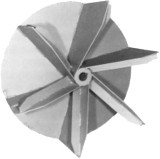 FAQ: industrial fan terminology translated from jargonese to easy-to-read
FAQ: industrial fan terminology translated from jargonese to easy-to-read
September 11, 2014 REDWIRE is news you can use from leading suppliers. Powered by FRASERS.
Posted by N.R. Murphy Limited
Since 1943, we have Experience In Custom Manufacturing Dust Collection Systems And Related Equipment. Also Includes: Cus... Read more
Subscribe
Free REDWIRE e-newsletter

The language of industry tends to be crammed with jargon, technical specifications and multiple compound words which sound they could have originated from another planet.
You may already be blown away by the overwhelming amount of resources on the various types of industrial fans: from axial fans, impeller fans, cooling fans, to centrifugal blowers, industrial exhausters or ventilation fans.
But what about a simple and seamless guide on how to decipher the owner’s manual once you buy that industrial fan?
While sophisticated terminology is used to describe the engineering and manufacturing process of industrial fans mechanisms, learning and understanding of how fans work doesn’t need to be complex.
When [it] hits the fan, know your fan fundamentals in a breeze by reading the below primer of essential industrial fan terms and abbreviations.
N. R. Murphy loves educating clients on dust collection and industrial fan solutions: if you have more questions after reading this brief tutorial, class is always in session at nrmurphy.com.
What is BHP?
Brake horsepower is a unit of measurement. Horsepower is the rate of the fan motor to work, which is determined by the resistance of the fan brake.
CFM means what exactly?
This is the abbreviation for cubic feet per minute, which is the volume of air moved per minute. When CFM is prefixed with an “S”, this means “standard” CFM. If an “A” is prefaced, this refers to as “actual” CFM.
How about FPM?
Stands for feet per minute defined as the velocity or speed of the airstream.
Free delivery (it's not what you think)
Defined as the condition under which a fan operates when no static pressure (SP) or resistance is present.
HP: Not to be confused with the name brand
HP is the shortened form of horsepower, which as previously explained is the actual, rated output of the fan motor used.
All about ME
It's not you or me, ME stands for mechanical efficiency. ME is the ratio of power output to power input.
psia: must be an important concept if all in lower case
One type of conventional unit of measurement to assess pressure is pounds per square inch absolute. The “a” in psia means absolute, which determines pressure relative inside a vacuum.
psig: another vital concept
Another type of conventional unit of measurement to evaluate pressure is pounds per square inch gauge or psig. The “g” of psig refers to gage pressure, which is calculating the atmospheric pressure at sea level.
BPM ≠ RPM
Not to be confused with BPM (or beats per minute in your heart) RPM, or revolutions per minute, calculates the number of times the fan shaft rotates each minute.
What is Standard Air?
Standard air is actually dry air weighing .075 pounds per cubic foot at 70°F with a barometric pressure of 29.92 inches of mercury.
Who or what is SP?
Static Pressure or commonly known as SP is a measure of the force exerted by the fan in moving air through any air handling system.
And VP?
Velocity pressure or VP corresponds to the average velocity determined from the volume of air moving through any air handling system.
TP feels complete when you add SP and VP together
TP is defined as total pressure. This is the sum of the static pressure (SP) and the velocity pressure (VP) at any given point in the air handling system.
Share
Posted by N.R. Murphy Limited
Since 1943, we have Experience In Custom Manufacturing Dust Collection Systems And Related Equipment. Also Includes: Cus... Read more
